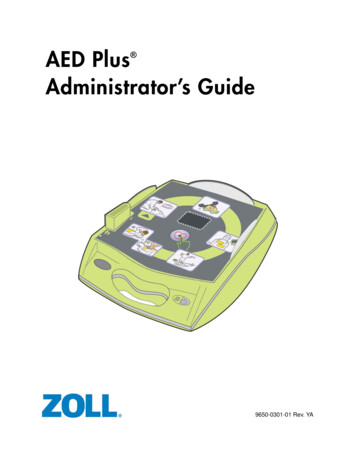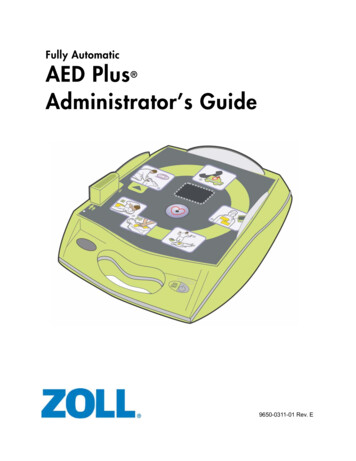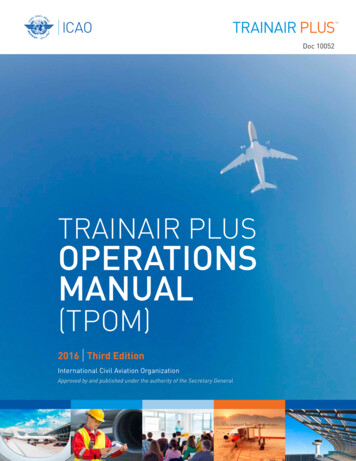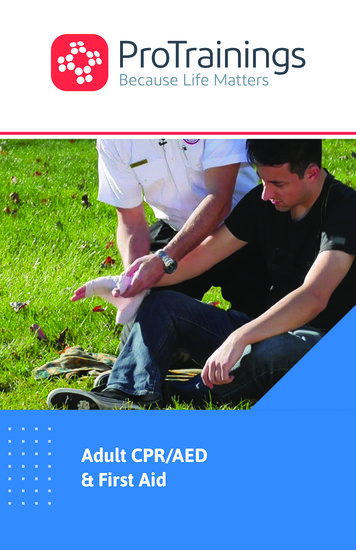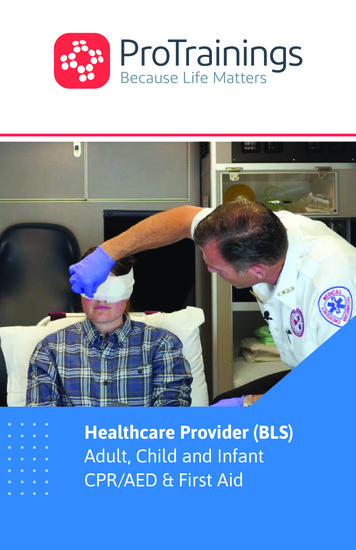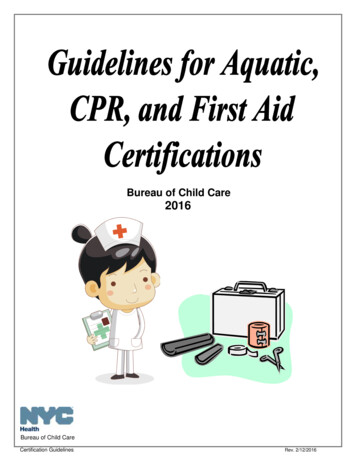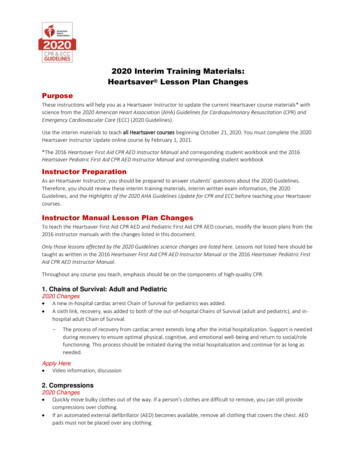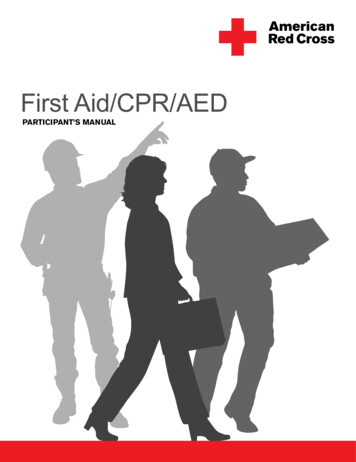
Transcription
AED PlusAdministrator’s Guide 9650-0301-01 Rev. X
This issue date for the ZOLL AED Plus Administrator’s Guide, (REF 9650-0301-01 Rev X) is March, 2016.If more than 3 years have elapsed since the issue date, contact ZOLL Medical Corporation to determine ifadditional product information updates are available.Copyright 2016 ZOLL Medical Corporation. All rights reserved. AED Plus, AED Pro, CPR-D-padz,M Series, pedi-padz, Real CPR Help, Rectilinear Biphasic, RescueNet, stat-padz and ZOLL aretrademarks or registered trademarks of ZOLL Medical Corporation in the United States and/or othercountries.All other trademarks and registered trademarks are property of their respective owners.ZOLL Medical Corporation269 Mill RoadChelmsford, MA USA01824-4105ZOLL International Holding B.V.Newtonweg 186662 PV ELSTThe Netherlands0123
Table of ContentsPREFACE . vSAFETY SUMMARY. viWarnings. viCautions . viiIndications for Use. viiContraindications for Use . viiIntended Users of the Device . viiTracking Requirements. viiiNotification of Adverse Events. viiiUnpacking . viiiConventions . viiiSymbols .ixINTRODUCTION . 1Using the ZOLL AED Plus .1Using Real CPR Help .2OPERATION. 3Operating Controls and Indicators.3Using the AED Plus Graphical User Interface.5Voice Prompts .6Using the LCD Display .9Using the Passive Airway Support System (PASS) . 10Using Electrodes. 11Applying CPR-D-padz . 12Applying pedi-padz II (Infant/Child Electrodes). 13Using the CPR Monitoring Function — Real CPR Help. 14Using the Audio Recording Option . 14INSTALLATION AND SELF TEST.15Inspecting the Unit. 15Preparing the AED Plus for Use. 15Using the Self Test Feature. 16Battery Installation Self Test . 16Power On Self Test . 17Manual Self Test. 17Automatic Self Test. 18Automatic Monthly Test (software version 5.32 or higher only) . 18Installing or Replacing Batteries. 18Identifying Battery Condition . 20MAINTENANCE AND TROUBLESHOOTING .22Maintaining the AED Plus. 22Maintenance Checklist . 22Cleaning the AED Plus. 22Optional Maintenance for Technical Professionals . 23Troubleshooting. 24Contacting Technical Service . 25International Customers. 25ZOLL ADMINISTRATION SOFTWARE .26Installing ZOLL Administration Software. 26RescueNet Code Review Software . 26Setting Up Data Communications. 26ORDERING ACCESSORIES .27APPENDIX A: SPECIFICATIONS .29ZOLL AED PLUS Administrator’s Guideiii
Guidance and Manufacturer’s Declaration - Electromagnetic Emissions . 32Rectilinear Biphasic Waveform Characteristics . 36Clinical Trial Results for the M Series Biphasic Waveform. 40Randomized Multi-Center Clinical Trial for Defibrillation of Ventricular Fibrillation (VF) and Ventricular Tachycardia (VT) . 40ECG Analysis Algorithm Accuracy. 42ivZOLL AED PLUS Administrator’s Guide
PrefaceThe AED Plus Administrator’s Guide is to be used by responsible medical authorities in conjunctionwith the ZOLL AED Plus Operator’s Guide (REF 9650-0300-01).The AED Plus is to be used by trained rescuers to provide emergency defibrillation. It incorporates asequence of visual and voice prompts to help rescuers follow established AHA/ERC Guidelines 2010protocols for use of AEDs. It also incorporates recording/memory capabilities to allow medicalcontrol authorities to review rescuer’s use of the device. Recording includes ECG rhythms, event data,device identification, and optionally, voice recording of rescuer and ambient sounds. This informationis available via an upload capability to a personal computer for event review and archiving.Both the American Heart Association (AHA) and the European Resuscitation Council (ERC) publishextensive information regarding the use of automated external defibrillators and their relationship tocardiopulmonary resuscitation. The following publications provide supplemental material to be usedin conjunction with the ZOLL AED Plus Administrator’s Guide and Operator’s Guide:1. 2010 American Heart Association Guidelines for CPR and ECC; Supplement to Circulation,Volume 192, Issue 18, November 12, 2010.2. European Resuscitation Council Guidelines for Resuscitation 2010; Resuscitation (2010) Volume81, October 2010.This guide provides information about the operation and care of the AED Plus unit. The administrator,and user should read each section carefully. Make sure to read the Safety Summary section.This guide is divided into six sections.Preface - This page.Safety Summary - Describes General Warnings and Cautions.Introduction- Provides a general product overview of the AED Plus.Section 1 - Operation - Describes the functions of all controls and indicator lights of the AED Plus.Section 2 - Installation, Self Test, Maintenance and Troubleshooting- Describes configuration of theunit, data communications, troubleshooting, maintenance and how to order accessories and supplies.Appendices - Provides the specifications of the AED Plus, characteristics of the ZOLL RectilinearBiphasic waveform, and information on the ECG Analysis Algorithm Accuracy.ZOLL AED PLUS Administrator’s Guidev
Safety Summar yThe following section describes general warnings and safety considerations for administrators, rescuers,and patients.Warnings Use the AED Plus unit only as described in this manual. Improper use of the device can cause deathor injury. DO NOT use or place the AED Plus unit in service until you have read the AED Plus Operator’s andAdministrator’s Guides. DO NOT use or place the AED Plus unit in service if the unit’s status indicator window (located onthe left side of the handle) displays a red “X”. DO NOT use or place the AED Plus unit in service if the unit emits a beeping tone. Connect the electrode cable to the AED Plus unit after installing batteries. Keep the electrode cable connected to the AED Plus unit at all times. This device should only be used by properly trained individuals. Only use electrodes labeled “Infant/Child” on children less than 8 years old or weighing less than55 lbs (25 kg). Use CPR-D-padz if victim is older than 8 years or weighs more than 55 lbs (25 kg). Always stand clear of victim when delivering a shock. Defibrillation energy delivered to the victimmay be conducted through the victim’s body and cause a lethal shock to those touching the victim. DO NOT TOUCH the electrode surfaces, the victim, or any conductive material touching the victimduring ECG analysis or defibrillation. Move victim away from electrically conductive surfaces prior to use of equipment. DO NOT use this unit near or within puddles of water. Keep the victim as motionless as possible during ECG analysis. DO NOT use this unit near flammable agents, such as gasoline, oxygen-rich atmospheres orflammable anesthetics. Avoid radio frequency interference from high-power sources that might cause the defibrillator tointerpret cardiac rhythms incorrectly by turning off cell phones and 2 way-radios. Disconnect non-defibrillation protected electronic devices or equipment from victim beforedefibrillation. Dry victim’s chest, if wet, before attaching electrodes. Apply freshly opened and undamaged electrodes, within the electrode expiration date, to clean anddry skin to minimize burning. DO NOT place the electrodes directly over the victim’s implanted pacemaker. Pacemaker stimulimay degrade the accuracy of ECG rhythm analyses or the pacemaker may be damaged bydefibrillator discharges. Check labeling inside the AED Plus cover before using the cover as a Passive Airway SupportSystem (PASS) device. Ensure it is intended for this use. DO NOT use Passive Airway Support System (PASS) if there is a suspected head or neck injury.Place victim on a firm surface before performing cardiopulmonary resuscitation. DO NOT recharge, disassemble, or dispose of batteries in fire. Batteries may explode, if mistreated. Do not use or stack the AED Plus unit with other equipment. If the unit is used or stacked with otherequipment, verify proper operation prior to use.viZOLL AED PLUS Administrator’s Guide
Cautions Do not disassemble the unit. A shock hazard exists. Refer all servicing to qualified personnel. Use only commercially available type 123A lithium manganese dioxide batteries. Discard batteriesproperly after removal from unit. Use only batteries from recommended manufacturers. If the device is stored outside the recommended environmental conditions, the electrode pads and/or batteries may be damaged or their useful life reduced. Safety and effectiveness data submitted by ZOLL Medical Corporation to the Food and DrugAdministration (FDA) under section 510(K) of the Medical Device Act to obtain approval tomarket are based upon the use of ZOLL accessories such as disposable electrodes. The use ofelectrodes from sources other than ZOLL is not recommended. ZOLL makes no representations orwarranties regarding the performance or effectiveness of its products when used in conjunctionwith electrodes from other sources. If unit failure is attributable to the use of accessories notmanufactured by ZOLL, this may void ZOLL's warranty. The CPR-D-padz electrode can be connected to other ZOLL Defibrillators with MultifunctionCables. Defibrillation can be administered when connected to other ZOLL Defibrillators. The CPRfunction does not operate with any device other than the AED Plus and AED Pro .Indications for UseUse the AED when a suspected cardiac arrest victim has an apparent LACK OF CIRCULATION asindicated by: Unconsciousness and Absence of normal breathing and Absence of a pulse or signs of circulation.When the victim is less than 8 years of age, or weighs less than 55 lbs (25 kg), the ZOLL AED Plusshould be used with the ZOLL AED Plus Pediatric Electrodes. Therapy should not be delayed todetermine the victim’s exact age or weight.Contraindications for UseDo NOT use the AED Plus when the victim: Is conscious; or Is breathing; or Has a detectable pulse or other signs of circulation.Intended Users of the DeviceThe AED Plus external defibrillator is intended to be used by personnel who are qualified by training inthe use of the AED Plus device, basic life support, advanced life support, or other physician-authorizedemergency medical response to defibrillate victims of cardiac arrest. The Real CPR Help functionprovides a metronome designed to encourage rescuers to perform chest compressions at the AHA/ERCrecommended rate of 100 compressions per minute. Voice and visual prompts encourage a minimumcompression depth of 2 inches for adult victims. The Real CPR Help function is not intended for use onvictims under 8 years of age.ZOLL AED PLUS Administrator’s Guidevii
Tracking RequirementsU.S Federal Law (21 CFR 821) requires the tracking of defibrillators. As an owner of this device, youhave the responsibility under this law to notify ZOLL Medical Corporation if this product has beenreceived, lost, stolen or destroyed or has been donated, resold or otherwise distributed to a differentorganization.If any of the events described above occur, please contact ZOLL Medical Corporation in writing with thefollowing information:1. Originator’s organization - Company Name, Address, Contact Name and Contact Phone Number.2. Part Number/Model Number and Serial Number.3. Disposition of Device (e.g. received, lost, stolen destroyed, distributed to another organization).4. New Location and/or Organization (if different from #1 above) - Company Name, Address, ContactName and Contact Phone number.5. Date change took effect.Notification of Adverse EventsAs a health care provider, you may have responsibilities under the Safe Medical Devices Act (SMDA)for reporting to ZOLL and possibly to the FDA, the occurrence of certain events. These events, describedin 21 CFR Part 803, include device related death and serious injury or illness. In any event, as part of ourQuality Assurance Program, ZOLL should be notified of any device failures or malfunction. Thisinformation is required to assure that ZOLL provides only the highest quality products.Unpacking Carefully inspect each packing container for damage. Examine the unit for any signs of damage that may have occurred during shipping. If the contents are incomplete or damaged or if the unit fails to pass its self test as indicated by a Red“X” in the status indicator window after battery installation, contact ZOLL Medical Corporation’sTechnical Service Department. Review the shipping list to insure that all items ordered were received.ConventionsThroughout this document, voice prompts are indicated by capital italicized letters, such asCALL FOR HELP.WARNING! Warning statements describe conditions or actions that can result in personalinjury or death.CAUTION! Caution statements describe conditions or actions that can result in damage to theunit.NOTE Notes contain additional information on using the defibrillator.viiiZOLL AED PLUS Administrator’s Guide
SymbolsSymbols used in this manual or on the equipment include the following: Class II equipmentDefibrillation protected Type BF patient connectionATTENTION: Refer to manual for more informationDANGEROUS VOLTAGENot new battery cellsNew battery cellsDo Not push buttonPush buttonDo not use this manufacturerOk to use this manufacturerUnit equipped to treat adult and pediatric victimsManufacturerAuthorized representative in the EuropeanCommunitySerial NumberCatalogue numberConsult instructions for useZOLL AED PLUS Administrator’s Guideix
xZOLL AED PLUS Administrator’s Guide
IntroductionUsing the ZOLL AED PlusThe AED Plus is an automated external defibrillator (AED) that uses voice prompts and visualindicators to guide the rescuer through a resuscitation sequence that may include defibrillation and/orcardiopulmonary resuscitation (CPR). The unit incorporates the ZOLL Rectilinear BiphasicDefibrillation waveform, and operates in either adult or pediatric mode.The AED Plus supports both adult and pediatric defibrillation electrode pads, and automaticallyadjusts the defibrillation energy based on the type of electrode pads connected to it. Followingattachment of electrodes to a victim’s chest, the defibrillator monitors the electrocardiographic (ECG)rhythm of the victim’s heart, analyzes that rhythm, and determines whether the rhythm is shockableor non-shockable. When needed, defibrillation energy is delivered through these same electrodes.When the unit detects a shockable rhythm, it charges and issues the warning PRESS FLASHINGSHOCK BUTTON. The rescuer presses the Shock Button to deliver the shock. The rescuer will thenbe prompted to perform CPR for a period of 2 minutes, after which the unit automatically initiates anew ECG analysis.Some versions of the AED Plus include a cover that can also be used as a PASS (Passive AirwaySupport System) to support the victim’s neck and shoulders in a position that assists in maintaining anopen airway. Some versions also contain disposable accessories (razor, barrier mask, scissors, and atowel). The AED Plus is powered by ten commercially available consumer brand lithium-manganesedioxide batteries.The AED Plus can: Perform periodic self tests to ensure its continual readiness. Use a one-piece electrode assembly (CPR D-padz) that facilitates proper electrode placement andthat is easy to apply to the victim. Analyze heart rhythm and inform the rescuer if the rhythm is shockable or non-shockable. Deliver defibrillation treatment to victims of cardiac arrest who exhibit shockable ECG rhythms. Provide voice prompts and graphics to guide the rescuer regarding what to do and when to do itduring a cardiac emergency, such as calling for help or giving CPR to the victim. Provide audible beeps to encourage rescuers to provide CPR compressions at 100 CPM (requiresCPR-D padz). Monitor the depth of chest compressions during CPR and provide voice prompts, if compressiondepth is inadequate (requires CPR-D padz). Provide a unit cover that functions as a Passive Airway Support System (PASS). (Note the PASSfeature is standard with some versions of the product and optional with others.) Upload data from the defibrillator to a computer to store events or print event reports. Use commercially available batteries.ZOLL AED PLUS Administrator’s Guide1
Using Real CPR Help The CPR-D padz include a sensor that detects the rate and depth of CPR chest compressions. Thissensor is placed (as part of the electrodes application) on the victim’s chest so that it is located betweenthe rescuer’s hands and the victim’s lower sternum during chest compressions. When the rescuerperforms CPR compressions, the sensor detects their rate and depth and sends the information to theAED Plus unit. When used with CPR-D padz, the AED Plus monitors the depth and rate of CPR chestcompressions. It provides a CPR metronome function designed to encourage rescuers to perform chestcompressions at the AHA/ERC recommended rate of 100 compressions per minute (CPM) as well asvoice and visual prompts to encourage a minimum compression depth of 2 inches for adult victims.WARNING! Real CPR Help is intended for use on adult victims only; do not use on victimsunder 8 years of age.The adaptive metronome function is disabled during periods when CPR should not be performed (forexample, during ECG analyses and defibrillation shock sequences). During periods when CPR may beindicated, the metronome begins issuing audible beeps following detection of the rescuer’s first fewcompressions. The beeps continue automatically (at rates described below) until a few seconds afterchest compressions are halted by the rescuer or until the recommended “CPR period” ends (2 minutesfor AHA and ERC protocols). If the rescuer ceases chest compressions during the CPR period,metronome beeps stop within a few seconds after compressions are halted. Audible beeps resumeduring the CPR period following any re-initiation of CPR compressions. If no CPR compressions aredetected during “CPR periods”, the AED Plus periodically re-issues the CONTINUE CPR prompt.The rate of beeps issued by the AED Plus adaptive metronome function adapts to the rescuer’s actualchest compression rate. The metronome will beep at 100 CPM when chest compressions are deliveredat greater than 80 compressions per minute (CPM). Should the rescuer fail to deliver compressions at80 CPM or greater, the metronome will beep at a rate that is approximately 15 CPM higher than therescuer’s actual rate. This increased metronome rate is intended to encourage the rescuer to increasehis/her chest compression rate until the recommended 100 CPM rate is achieved. The metronome beepsat a minimum rate of 60 CPM in cases where the rescuer’s compression rate is substantially below60 CPM.During CPR, the AED Plus may issue one or more audible prompts based on the depth of chestcompressions detected. When Real CPR Help determines that compression depth is consistently lessthan 2 inches, a PUSH HARDER prompt will be issued. A GOOD COMPRESSION prompt will beissued if the rescuer responds by increasing compression depth to 2 inches or more.The AED Plus unit can be configured to display the FULLY RELEASE text prompt to remind the userto lift the hands off the chest during CPR. By default, this text prompt is not enabled.2ZOLL AED PLUS Administrator’s Guide
OperationThis section describes the following functions: Operating Controls and Indicators Using the AED Plus Graphical User Interface Voice Prompts Using the LCD Display Using the Passive Airway Support System (PASS) Using Electrodes Applying CPR-D-padz Applying pedi-padz II (Infant/Child Electrodes) Using the CPR Monitoring Function — Real CPR Help Using the Audio Recording OptionOperating Controls and IndicatorsSee Table 1: Control Functions for an explanation of each of these controls.LCD Display (not supplied on some units)Electrode ConnectorGraphicsIrDA Port (on side of unit)Indicator LightsStatus IndicatorBattery Compartment (bottom)Carrying HandleMicrophone (hidden)On/Off ButtonSpeaker (bottom)Shock ButtonFigure 1: Identifying Operating Controls and IndicatorsZOLL AED PLUS Administrator’s Guide3
Table 1: Control FunctionControl/IndicatorDescriptionON/OFF ButtonTurns power ON or OFF.When held depressed for 5 seconds initiates self test or datacommunications.Indicator lightsIlluminates to indicate which step rescuer must take to treat a victim.Shock ButtonIlluminates when the AED Plus is charged and ready to deliver a shock to thevictim.When pressed, causes the charged and ready AED Plus to discharge itsenergy into the victim.When the AED Plus is not charged the lighted button is extinguished.Pressing this button initiates a voice prompt that indicates the number ofdefibrillator shocks delivered since the unit was powered on.PictogramsIcons that explain the series of steps needed for resuscitation anddefibrillation.Status IndicatorIlluminated check mark indicates the unit passed its last self test and is readyfor use.Illuminated “X” indicates unit has failed its self test and is not ready for use4LCD DisplayDisplays elapsed time, shock count, user prompts, CPR compression depthsand ECG waveforms.IrDA Po
The AED Plus external defibrillator is intended to be used by personnel who are qualified by training in the use of the AED Plus device, basi c life support, advanced life suppor t, or other physician-authorized emergency medical response to defibrillate victims of card
